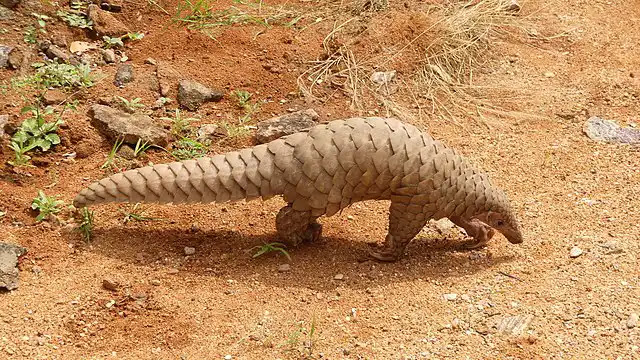Facts about Pangolins: Pangolins, also known as scaly anteaters, are unique and fascinating animals that are native to Africa and Asia. With their armor-like scales and tongue that is longer than their body, pangolins are unlike any other species in the world. However, despite their unique adaptations, pangolins are also facing numerous threats, including illegal hunting and habitat loss. In this article, we will explore some of the most interesting and important facts about these incredible creatures.
50 Facts About the Pangolin: Scaly Anteater with Unique Adaptations
Physical Characteristics
- Pangolins are covered in hard, keratin scales that protect them from predators.
- They are sometimes called "scaly anteaters" because of their appearance.
- Pangolins have long, sticky tongues that they use to collect ants and termites from their nests.
- They have powerful front claws that they use to break into ant and termite mounds.
- Pangolins can curl up into a tight ball when threatened, with their scales providing a barrier against predators.
- They are nocturnal animals and spend most of the day sleeping.
- Pangolins are found in a variety of habitats, including forests, savannas, and deserts.
- They have a slow metabolism and can go long periods without eating.
- Pangolins are good swimmers and can use their tails to grasp branches.
- They have poor eyesight and rely mainly on their sense of smell to locate food.
Behavior
- Pangolins are solitary animals and only come together to mate.
- They are shy and elusive, making them difficult to study in the wild.
- They have a distinctive gait, walking on their hind legs and using their tails for balance.
- Pangolins are active at night and forage for food for several hours.
- They have a slow reproductive rate, with females giving birth to only one or two young at a time.
- Young pangolins are born with soft scales that harden as they mature.
- Pangolins are known to mark their territory with urine and feces.
- They are capable of making vocalizations, including growls, barks, and hisses.
- Pangolins are known to roll into a tight ball when they sense danger, and can use their sharp scales as a defense mechanism.
- They are capable of self-anointing, where they spread a sticky substance over their bodies to mask their scent from predators.
Conservation Status
- Pangolins are considered to be the most trafficked mammal in the world.
- They are hunted for their meat, which is considered a delicacy in some cultures, and for their scales, which are used in traditional medicine.
- All eight species of pangolin are currently listed as either endangered or critically endangered by the IUCN.
- Habitat destruction and deforestation have also impacted pangolin populations.
- In 2016, the international trade in pangolins and their products was banned under CITES.
- Conservation efforts are underway in some countries to protect pangolin populations, including habitat restoration and anti-poaching measures.
- In-situ conservation programs have been established to breed pangolins in captivity and release them into protected areas in the wild.
- Increased awareness and education campaigns have been launched to reduce demand for pangolin products.
- Research into pangolin biology and behavior is ongoing to support conservation efforts.
- International cooperation is needed to ensure the survival of pangolin populations, as they are threatened by illegal trafficking across borders.
Range and Distribution
- Pangolins are native to Africa and Asia, with four species found in each region.
- In Africa, pangolins are found in countries such as Ghana, Kenya, and South Africa.
- In Asia, pangolins are found in countries such as China, India, and Indonesia.
- Some species have a widespread range, while others have a more restricted distribution.
- Pangolins have adapted to a variety of habitats, including forests, savannas, and deserts.
- Some species are arboreal, spending much of their time in trees, while others are more terrestrial and spend time on the ground.
- The distribution of pangolins has declined in recent years due to habitat loss and illegal hunting.
- Some species are also introduced to new areas through illegal wildlife trafficking.
- Range countries are working to protect pangolins through anti-poaching measures and habitat conservation.
- Conservation organizations are also promoting habitat restoration and reforestation initiatives to support pangolin populations.
Diet and Feeding
- Pangolins are insectivores and feed primarily on ants and termites.
- They have long, sticky tongues that they use to extract insects from their nests.
- Pangolins have a keen sense of smell, which they use to locate food.
- They have powerful front claws that they use to break into ant and termite mounds.
- Pangolins have slow metabolisms and can go long periods without eating.
- Their diet is supplemented with other insects, such as beetles and caterpillars.
- In captivity, pangolins have been known to feed on fruits, vegetables, and other food sources.
- Pangolins play an important role in their ecosystem as insectivores, helping to control ant and termite populations.
- Changes in their habitat and food sources can have a significant impact on pangolin populations.
- Research is ongoing to better understand the dietary needs and habits of pangolins in the wild.
Pangolins are truly remarkable animals, with a range of adaptations that make them perfectly suited to their insect-based diet and habitats. However, despite these adaptations, pangolins are facing numerous threats, including illegal hunting and habitat loss. In order to protect these fascinating creatures, it is important that we raise awareness about their unique biology and the challenges they face, and work to promote conservation efforts that will help to ensure their survival for generations to come. Whether you are a seasoned conservationist or just learning about pangolins for the first time, these facts are sure to inspire a deeper appreciation for this incredible species.














0 Comments